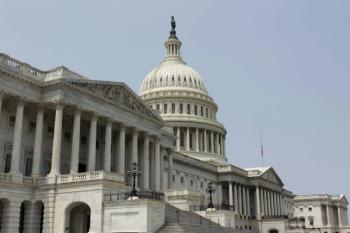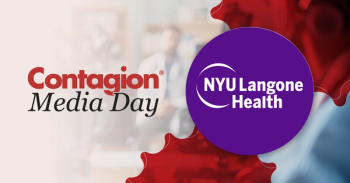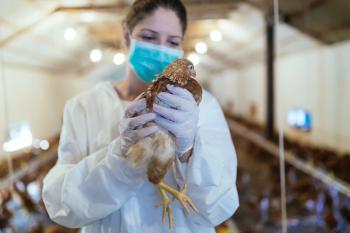
- August 2020
- Volume 5
- Issue 4
Using IL-6 Inhibitors to Treat COVID-19
Use of an IL-6 inhibitor has the potential to prevent the cytokine storm caused by severe COVID-19 infection.
Interleukin-6 (IL-6) is a cytokine responsible for organ development, inflammation, and immune responses.1 As a key stimulator of acute phase proteins, IL-6 is associated with proinflammatory responses, particularly when dysregulated or continually synthesized.2 Exaggerated synthesis of IL-6 in the lungs, secondary to the presence of the nucleocapsid protein of severe acute respiratory syndrome coronavirus 2, has been linked to cytokine release syndrome (CRS) in critically ill
In general, IL-6 inhibitors prevent human IL-6 from binding to IL-6 receptors, thus impeding the formation of immune signaling complexes on cell surfaces. Differences exist in drug target and binding affinity for human IL-6, but it is unclear how these impact COVID-19 treatment. Specifically, TOCI is a humanized mAB that binds to soluble and membrane-bound IL-6 receptors, whereas SARI is a fully human anti—IL-6 receptor mAb.8 SILT is a chimeric, human—murine mAB that binds to and neutralizes the human IL-6 cytokine itself.9 There are no known differences in efficacy among these agents for their labeled indications or in COVID-19 infections.
Few data describe the pharmacokinetics of IL-6 inhibitors, which can vary from linear (TOCI, SILT) to Michaelis—Menten (SARI).10-13 The half-life of these agents can range from 8 to 30 days, with no noted dose adjustments for renal or hepatic disease; however, safety data in specialized populations are limited.11-13 Most toxicities of IL-6 inhibitor use have been observed with long-term use and include neutropenia, thrombocytopenia, elevated liver enzymes, rash, and pruritis. However, neutropenia and thrombocytopenia have been reported with short-term IL-6 inhibitor use in COVID-19 patients, and caution should be exercised in patients with low neutrophil or platelet counts.
Data surrounding the use of IL-6 inhibitors to treat COVID-19 infections are still emerging, and currently available evidence includes case reports, case series, and nonrandomized trials with and without control groups.
The use of TOCI in 9 patients with COVID-19 pneumonia or respiratory failure were documented in 6 case reports.14-19 Patient age ranged from 40 to 71 years, and 6/9 (66.7%) patients were male. TOCI administration occurred after worsening chest imaging or shortness of breath in 8 of 9 patients. Three patients received monotherapy with TOCI, while 6 received concomitant lopinavir—ritonavir (L/r), hydroxychloroquine (HCQ) + azithromycin (AZM), or HCQ + L/r. No adverse drug reactions (ADRs) occurred. Two of the 9 patients expired.
A TOCI case series by Luo et al examined 15 COVID-19—positive patients whose median age was 73 years: 2 (13.3%) were moderately ill, 6 (40%) severely ill, and 7 (46.7%) critically ill.20 All patients received a single dose of TOCI (80-600 mg), while 5 (33%) received 2 to 3 doses. Eight (53%) patients received concomitant methylprednisolone. Nine (60%) patients were stabilized post TOCI therapy, 2 (13.3%) experienced worsened COVID-19 symptoms, and 3 (20%) patients expired.
A TOCI case series by Xu et al included 21 patients with either severe (81%) or critical (19%) COVID-19 infection.21 The average age was 57 years, and 18 (86%) patients were male. All included patients had abnormal chest CT imaging documenting ground glass opacities or bilateral infiltrates. Eighteen (86%) patients received 1 dose of TOCI, while 3 (14%) patients received 2 doses. All patients had dyspnea, fever, and elevated C-reactive protein (CRP), IL-6, and white blood cells. Within 24 hours, all patients experienced defervescence, and within 5 days, 15 (71%) had reduced oxygen requirements. No patients experienced any ADRs.
A SILT case series included 21 COVID-19 patients with acute respiratory distress syndrome requiring noninvasive ventilation (NIV).22 The median age was 64 years, and all patients received the standard of care (SOC) combined with SILT 11 mg/kg/day. Five (24%) patients received a second dose. Eighteen (86%) received SILT within 24 hours of NIV. Improvement in symptoms occurred in 7 (33%) patients, 9 (43%) patients stabilized, and 5 (24%) had worsening symptoms resulting in intubation or death.
A study by Sciascia et al included 63 patients with a mean age of 63 years who received a single dose of TOCI at either 8 mg/kg intravenously (IV) or 324 mg subcutaneously.23 Administration of the drug within 6 days of admission was associated with a 2-fold increased likelihood of survival and an increase in partial pressure of arterial oxygen/fraction of inspired oxygen ratio by day 14. Toniati et al examined 100 patients with severe COVID-19 pneumonia requiring mechanical ventilation (MV).24 The median age was 62 years, and 88 (88%) patients were male. Eighty-seven (87%) patients received 2 doses of TOCI at 8 mg/kg (maximum, 800 mg) given 12 hours apart, and 13 (13%) patients received a third dose 24 hours later. Within 72 hours of TOCI administration, 58 had improvement in respiratory symptoms, while 5 worsened. At 10 days post TOCI, 77 had improved respiratory function, 23 had worsening function, and 20/23 (87%) had died. Three patients experienced ADRs (2, septic shock and death; 1, gastrointestinal perforation).
A phase 2 study was conducted comparing SARI 400 mg vs 200 mg vs placebo in 457 patients with COVID-19 infection.25 The patients were classified as having either severe illness (28%), critical illness (49%), or multisystem organ dysfunction (23%). Preliminary analysis demonstrated that SARI rapidly lowered CRP with no ADRs observed. Approximately 365 (80%) patients were discharged alive, 45 (10%) died, and 45 (10%) remained hospitalized at the interim analysis.
Another comparator study examined the composite end point of intensive care unit (ICU) admission and/or mortality in 45 COVID-19 patients who received either 1 or 2 doses of TOCI or SOC (HCQ or L/r + antibiotics +/— corticosteroids).27 Patients in the TOCI group were more likely to be 70 years or older and had higher Charlson Comorbidity Index scores, oxygen requirements, and greater lymphopenia and CRP than patients in the SOC group. However, patients in the TOCI group had lower rates of MV and ICU admission and/or death (72% vs 25%).
Roumier et al matched TOCI patients to SOC patients based on age, gender, and disease severity.28 Sixty included patients (30 [50%] TOCI, 30 [50%] SOC) were less than 80 years of age and had severe, rapidly deteriorating pneumonia, high CRP, and at least 5 days of COVID-19 infection. Their median age was 50 years, and 48 (80%) were male. Patients were given 1 to 2 doses of IV TOCI 8 mg/kg. Two (6.7%) TOCI patients also received HCQ and AZM, and 2 (6.7%) control patients received high-dose methylprednisolone. After 8 days, TOCI reduced the requirement for MV (weighted odds ratio [OR], 0.42; 95% CI, 0.20-0.89), and TOCI patients were more likely to avoid ICU admission (weighted OR, 0.17; 95% CI, 0.06-0.48). Three (10%) TOCI patients experienced ADRs: mild hepatic cytolysis (2/30, 6.7%) and ventilator-associated pneumonia (1/30, 3.3%).
When examining all currently available data, it appears that IL-6 inhibitors have the potential to be used in those COVID-19 patients who have extensive lung involvement and elevated IL-6 concentrations. Care should be taken to watch for the development of neutropenia, thrombocytopenia, and liver injury. Additionally, optimal timing of IL-6 inhibitor initiation is unknown, as symptoms can worsen in some patients after administration. Results from randomized controlled trials can shed light on what the true place in therapy is for IL-6 inhibitors in the fight against COVID-19.
Wagner is a clinical assistant professor at the University of Mississippi School of Pharmacy with a practice site at the University of Mississippi Medical Center. She currently serves as the chair of the SIDP Antimicrobial Stewardship Committee and as a committee member for the ACCP ID PRN Research Committee.
Veve is a clinical assistant professor at the University of Tennessee College of Pharmacy. He maintains practice as an infectious diseases clinical pharmacist at the University of Tennessee Medical Center.
Barber is an assistant professor at the University of Mississippi School of Pharmacy and a clinical specialist in infectious diseases at the University of Mississippi Medical Center.
References
- Hirano T. Interleukin 6 and its receptor: ten years later. Int Rev Immunol. 1998;16(3-4):249-284. doi:10.3109/08830189809042997
- Gauldie J, Richards C, Harnish D, et al. Interferon beta 2/B-cell stimulatory factor type 2 shares identity with monocyte-derived hepatocyte-stimulating factor and regulates the major acute phase protein response in liver cells. Proc Natl Acad Sci U S A. 1987;84(20):7251-7255. doi:10.1073/pnas.84.20.7251
- Magro G. SARS-CoV-2 and COVID-19: what are our options? where should we focus our attention on to find new drugs and strategies? Travel Med Infect Dis. Published online April 22, 2020. doi:10.1016/j.tmaid.2020.101685
- Zhang W, Wu K, Wang D, et al. Nucleocapsid protein of SARS-CoV activates interleukin-6 expression through cellular transcription factor NF-kappaB. Virology. 2007;365(2):324‐335. doi:10.1016/j.virol.2007.04.009
- Herold T, Jurinovic V, Arnreich C, et al. Level of IL-6 predicts respiratory failure in hospitalized symptomatic COVID-19 patients. J Allergy Clin Immunol. Published online 2020. doi:10.1016/j.jaci.2020.05.008
- Ruan Q, Yang K, Wang W, et al. Clinical predictors of mortality due to COVID-19 based on an analysis of data of 150 patients from Wuhan, China. Intensive Care Med. 2020;46(5):846-848. doi:10.1007/s00134-020-05991-x
- Buonaguro FM, Puzanov I, Ascierto PA. Anti-IL6R role in treatment of COVID-19-related ARDS. J Transl Med. 2020;18(1):165. doi:10.1186/s12967-020-02333-9
- Bae S, Lee YH. Comparison of the efficacy and tolerability of tocilizumab, sarilumab, and sirukumab in patients with active rheumatoid arthritis: a Bayesian network meta-analysis of randomized controlled trials. Clin Rheumatol. 2018;37(6):1471-1479. doi:10.1007/s10067-018-4006-5
- Sarosiek S, Shah R, Munshi NC. Review of siltuximab in the treatment of multicentric Castleman’s disease. Ther Adv Hematol. 2016;7(6):360‐366. doi:10.1177/2040620716653745
- Xu C, Su Y, Paccaly A, Kanamaluru V. Population pharmacokinetics of sarilumab in patients with rheumatoid arthritis. Clin Pharmacokinet. 2019;58(11):1455-1467. doi:10.1007/s40262-019-00765-1
- Actemra (tocilizumab). Prescribing information. Genentech; 2013. Accessed June 1, 2020. https://www.accessdata.fda.gov/drugsatfda_docs/label/2013/125276s092lbl.pdf
- Kevzara (sarilumab). Prescribing information. Sanofi-Aventis US; 2018. Accessed June 1, 2020. https://www.accessdata.fda.gov/drugsatfda_docs/label/2018/761037s001lbl.pdf
- Sylvant (siltuximab). Prescribing information. Janssen Biotech; 2014. Accessed June 1, 2020. https://www.accessdata.fda.gov/drugsatfda_docs/label/2014/125496s000lbl.pdf
- Michot JM, Albiges L, Chaput N, et al. Tocilizumab, an anti-IL-6 receptor antibody, to treat COVID-19-related respiratory failure: a case report. Ann Oncol. Published online April 2, 2020. doi:10.1016/j.annonc.2020.03.300
- Zhang X, Song K, Tong F, et al. First case of COVID-19 in a patient with multiple myeloma successfully treated with tocilizumab. Blood Adv. 2020;4(7):1307-1310. doi:10.1182/bloodadvances.2020001907
- Radbel J, Narayanan N, Bhatt PJ. Use of tocilizumab for COVID-19-induced cytokine release syndrome: a cautionary case report. Chest. Published online April 25, 2020; doi:10.1016/j.chest.2020.04.024
- Mihai C, Dobrota R, Schröder M, et al. COVID-19 in a patient with systemic sclerosis treated with tocilizumab for SSc-ILD. Ann Rheum Dis. 2020;79(5):668-669. doi:10.1136/annrheumdis-2020-217442
- Cellina M, Orsi M, Bombaci F, et al. Favorable changes of CT findings in a patient with COVID-19 pneumonia after treatment with tocilizumab. Diag Intervent Imag. 2020;101(5):323-324. doi:10.1016/j.diii.2020.03.010
- Di Giambenedetto S, Ciccullo A, Borghetti A, et al; GEMELLI AGAINST COVID-19 Group. Off-label use of tocilizumab in patients with SARS-CoV-2 infection. J Med Virol. Published online April 16, 2020. doi:10.1002/jmv.25897
- Luo P, Liu Y, Qiu L, et al. Tocilizumab treatment in COVID-19: a single center experience. J Med Virol. 2020;92(7):814-818. doi:10.1002/jmv.25801
- Xu X, Han M, Li T, et al. Effective treatment of severe COVID-19 patients with tocilizumab. Proc Natl Acad Sci U S A. 2020;117(20);10970-10975. doi:10.1073/pnas.2005615117
- Gritti G, Raimondi F, Ripamonti D, et al. Use of siltuximab in patients with COVID-19 pneumonia requiring ventilatory support. medRxiv. Published online May 22, 2020. doi:10.1101/2020.04.01.20048561
- Sciascia S, Aprà F, Baffa A, et al. Pilot prospective open, single-arm multicentre study on off-label use of tocilizumab in patients with severe COVID-19. Clin Experim Rheum. 2020;38(3):529-532.
- Toniati P, Piva S, Cattalini M, et al. Tocilizumab for the treatment of severe COVID-19 pneumonia with hyperinflammatory syndrome and acute respiratory failure: a single center study of 100 patients in Brescia, Italy. Autoimmun Rev. 2020;19(7):102568. doi:10.1016/j.autrev.2020.102568
- Sanofi and Regeneron provide update on U.S. Phase 2/3 adaptivedesigned trial in hospitalized COVID-19 patients. News release. Regeneron and Sanofi; April 27, 2020. Accessed May 13, 2020. https://www.sanofi.com/en/media-room/press-releases/2020/2020-04-27-12-58-00
- Regeneron and Sanofi. (2020) Sanofi and Regeneron provide update on Kevzara® (sarilumab) Phase 3 U.S. trial in COVID-19 patients [Press release]. 2 July 2020. Available at https://www.sanofi.com/en/media-room/press-releases/2020/2020-07-02-22-30-00 (Accessed July 23, 2020).
- Klopfenstein T, Zayet S, Lohse A, et al; HNF Hospital Tocilizumab Multidisciplinary Team. Tocilizumab therapy reduced intensive care unit admissions and/or mortality in COVID-19 patients. Med Mal Infect. Published online May 6, 2020. doi:10.1016/j.medmal.2020.05.001
- Roumier M, Paule R, Groh M, et al. Interleukin-6 blockade for severe COVID-19. medRxiv 2020. Published online April 22, 2020. doi:10.1101/2020.04.20.20061861
Articles in this issue
over 5 years ago
Antiretroviral Stewardship: The Time is Nowover 5 years ago
Hydroxychloroquine for COVID-19: A Lesson in Study QualityNewsletter
Stay ahead of emerging infectious disease threats with expert insights and breaking research. Subscribe now to get updates delivered straight to your inbox.



















































































































































































































































































